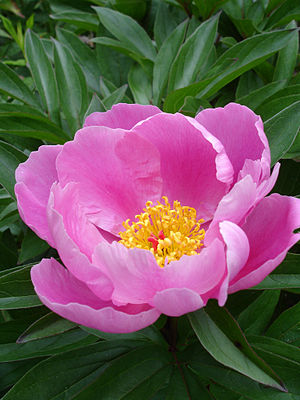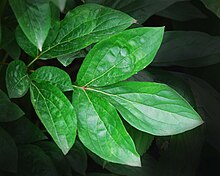Paeonia lactiflora
| Paeonia lactiflora | ||||||||||||
|---|---|---|---|---|---|---|---|---|---|---|---|---|

Wild form of Paeonia lactiflora |
||||||||||||
| Systematics | ||||||||||||
|
||||||||||||
| Scientific name | ||||||||||||
| Paeonia lactiflora | ||||||||||||
| Pall. |
Paeonia lactiflora , sometimes called Milky White Peony or Chinese Peony , is a species of the peony family (Paeoniaceae). It is native to Central and East Asia, from southern Siberia, Mongolia, Tibet to northern China to the Russian Far East and Korea. It isusedas an ornamental plant with many varieties, also known as the noble peony .
description
The species Paeonia lactiflora differs from many other species of the genus in that it has a diploid set of chromosomes and, in addition to a terminal flower, also has side buds.
Vegetative characteristics
Paeonia lactiflora grows as a perennial herbaceous plant and reaches heights of 50 to 60 cm. The stem is glabrous and light green in color with tinges of red.
The lower leaves are double threefold (biternate). The leaf blade is undivided, rarely lobed, elliptical to lanceolate with a wedge-shaped base and a pointed to pointed, more rarely rounded or pointed upper end. The leaf margins are serrated with small cartilaginous teeth. The upper side of the leaf is dark green and glabrous with the exception of hairs on the leaf veins and the underside of the leaf is glabrous or with short hairs on the leaf veins.
Generative characteristics
Each stem bears two or more flowers. The pleasantly sweet smelling, hermaphrodite flowers are radial symmetry with a diameter of 6 to 7 cm. The white petals are obovate and measure 3 to 4 (up to 5 cm) in length and 2 to 3 cm in width. The many stamens are 1.5 cm long. The stamens and anthers are yellow. There are four to five free, bald carpels .
There are follicles formed.
Chromosome number
The number of chromosomes is 2n = 10.
Occurrence
distribution
The East Asian distribution area Paeonia lactiflora stretches in the west from Baikal to Ussuria on the Pacific in the east, as well as from southern Siberia ( Dauria , also called Transbaikal region) to Tibet . In China, Paeonia lactiflora occurs in Inner Mongolia , Manchuria and on the Wutai Shan in Shanxi . Paeonia lactiflora is also common in North Korea and Mongolia .
Locations and plant sociology
The locations and ecology of the milk white peony were described in more detail in the Soviet Union by Alexander M. Zarubin and TI Bykova in 1988. According to this, Paeonia lactiflora is widespread in steppes and forest steppes. Locations are open stony embankments , dry grass on river terraces , in forest clearings, light forest edges, in groups of shrubs, in broad river valleys and the embankments of river banks. They are plant-sociological components of many mixed plant communities .
In the background Baikal region also genuine Peony steppes are found. They have been described in southeastern Daurien from an area behind the Klitschkinskij Mountains , east of the village of Dono . These peony steppes are found on mountain slopes and in ravines at different exposures and different steep slopes. Locations are only flat or slightly hilly habitats . Accompanying grasses are medium-high and moderately closed at these locations. When soils are stony, little black humuse Rendzinas , more rarely dark-brown forest soils or steppe soils populated.
In the peony steppes, Paeonia lactiflora dominates with a steadiness of 200 to 300 specimens per 100 m². The peonies with a degree of coverage of 20 to 40% are the characteristic species of the peony steppe. In addition, Stipa baicalensis , Koeleria cristata , Leymus chinensis and Poa attenuata are dominant. Additionally Scabiosa comosa , Lilium pumilum , Iris dichotoma , Scutellaria baicalensis , Veronica dahurica , Bupleurum scorzonerifolium , Galium verum , versicolor Dianthus , Dictamnus dasycarpus , Platycodon grandiflorus , schizonepeta multifida , Trigonella ruthenica , Sanguisorba officinalis , Serratula centauroides , Trifolium lupine aster , Potentilla tanacetifolia , Filifolium sibiricum .
Peonia lactiflora also occurs as a component of other steppe types ( Tanacetum , Stipa, etc.).
However, due to heavy grazing , peony nests die over time.
Systematics
No subspecies are currently excreted in their range.
In 1776, Peter Simon Pallas validly listed this peony as Paeonia lactiflora with the associated protologue (first mention) in the third volume of the journey through various provinces of the Russian Empire . Pallas had this type of plant on 6/7. July 1772 in the mountains around Lake Baikal and in the catchment area of the Selenga . He noted in the protologue to Paeonia lacteo flore (sic): A species that is sufficiently differentiated from the common peonies by its flowers and leaves .
Pallas later set up an invalid synonymy in the list of a new epithet for Paeonia albiflora , which was published in his Flora Russia in 1788. Thereafter, Pallas' erroneous synonymy was continued by both Henry Charles Andrews and Aimé Bonpland as the scientific name of the species. The valid, accepted scientific name is the first mention in the Protolog 1776.
In the classical description of this genus Paeonia by Stern in 1946 that turned Paeonia lactiflora in the section Paeon , subsection Foliolatae in the group lactiflorae . In the latest revision of Paeonia , Hong De-Yuan 2010 has Paeonia lactiflora and its closest related species Paeonia emodi Wall. ex Royle, Paeonia sterniana HRFletcher and Paeonia anomala L. with the subspecies Paoniea anomala subsp. veitchii DY Hong & KY Pan to Section III. Paeonia placed in the Albiflorae (Salm-Dyck) DY Hong subsection .
History as an ornamental plant and variety
The wild species was introduced to Europe by Abraham Hume (1810) and Whiley (1808) in the early 19th century. Paeonia lactiflora is the most important horticultural peony today due to its striking, often double-flowered varieties.
Paeonia lactiflora has been used as a useful and ornamental plant in East Asia for thousands of years. First evidence of its use as an ornamental plant was documented in China for the first century and in 536 several cultivars were distinguished here. The first horticultural cultivars of the noble peony as gifts from the Chinese Emperor to Napoleon came to Europe at the beginning of the First Empire . Thanks to Joséphine's support and the descendants of the plants in her collection of peonies in the garden of the Malmaison Castle , these were soon popularized in France and subsequently throughout Europe.
Most of today's modern garden varieties of peonies are derived from the milk white peonies (the exception are the peasant peonies, which are varieties of the common peony).
The several hundred selected cultivars are distinguished by their flower shape, size, color and flowering time. Many varieties are double filled; in these, the stamens are transformed into additional petals.
Hybrids with other species have also been bred for several decades, but compared to the varieties of Paeonia lactiflora they always bloom earlier, have very rarely double flowers, have no scent, are often hairy (stems, leaves, carpels) and are different The leaf shape, the pinnate division of the lower leaves and, in general, the sheen of the foliage (with the exception of hybrids that were crossed with Paeonia peregirna ) are clearly different from lactiflora varieties.
Cultivars
Overview of some important double peonies and their introduction
Hybrids
Species hybrids of wild peonies with Paeonia lactiflora are used by peony breeders to breed new color variations and flower shapes. A crossroads between the Paeonia lactiflora and species Paeonia peregrina 'Otto Froebel' resulted, for example, the hybrids 'Pink Hawaiian Coral', a half-filled hybrid with the foliage type Paeonia peregrina and fragrant flowers of Paeonia lactiflora , 2000 by the American Peony Society the of the “Gold-Award” awarded by the breeders' association as well as the “Award of Landscape Merit” in 2009.
credentials
- ↑ a b Eckehart J. Jäger, Friedrich Ebel, Peter Hanelt, Gerd K. Müller (eds.): Exkursionsflora von Deutschland . Founded by Werner Rothmaler. tape 5 : Herbaceous ornamental and useful plants . Springer, Spektrum Akademischer Verlag, Berlin / Heidelberg 2008, ISBN 978-3-8274-0918-8 , pp. 216 .
- ↑ Gordon Cheers (Ed.): Botanica. The ABC of plants. 10,000 species in text and images . Könemann, Cologne 2003, ISBN 3-8331-1600-5 , p. 632 .
- ↑ FC Stern: A Study of the Genus Paeonia. The Royal Horticultural Society, London 1946, p. 33 (online)
- ↑ Paeonia lactiflora at Tropicos.org. In: IPCN Chromosome Reports . Missouri Botanical Garden, St. Louis
- ↑ Reinhilde Frank: Peonies . 2nd Edition. Eugen Ulmer, Stuttgart, 1999, ISBN 3-8001-6639-9 .
- ↑ a b c d e f Alexander M. Zarubin, TI Bykova (А. М. Зарубин, Т. И. Быкова): Milky white peony - bio-ecological characteristics of the Siberian flora, need to preserve it. Novosibirsk 1988, pp 133-148 (in Russian; in the original: Пион молочноцветковый - Биоэкологические особенности растений Сибири, нуждающихся в охране. (Full German translation by Carsten Burkhardt) .
- ↑ Peter Simon Pallas : Journey through different provinces of the Russian Empire . Volume 3, 1776, p. 285, (online)
- ↑ Peter Simon Pallas : Journey through different provinces of the Russian Empire . Volume 3, 1776, p. 286, (online)
- ^ Josef J. Halda, James W. Waddick: The Genus Paeonia . Timber Press, Portland 2004, ISBN 0-88192-612-4 , pp. 196–205 ( limited preview in Google Book search).
- ↑ De-Yuan Hong: Peonies of the World. Volume 2. Polymorphism and Diversity. Royal Botanic Gardens, Kew u. a. 2011, ISBN 978-1-84246-458-8 , PDF; 2.6 MB) ( Memento of the original from January 24, 2012 in the Internet Archive ) Info: The archive link was inserted automatically and has not yet been checked. Please check the original and archive link according to the instructions and then remove this notice.
- ↑ FC Stern: A Study of the Genus Paeonia. The Royal Horticultural Society, London 1946, p. 92 (online)
- ↑ a b Michel Rivière: Magnificent Peonies. Eugen Ulmer, Stuttgart, 1995, ISBN 3-8001-6560-0 , p. 96.
- ↑ a b Michel Rivière: Magnificent Peonies. Eugen Ulmer, Stuttgart, 1995, ISBN 3-8001-6560-0 , p. 101.
- ^ H. Peter Loewer: Fragrant Gardens. How to Select and Make the Most of Scented Flowers and Leaves (= Taylor's Weekend Gardening Guides ). Houghton Mifflin, New York 1999, ISBN 0-395-88492-6 , pp. 48 ( limited preview in Google Book search).
- ^ "Award of Landscape Merit" from the American Peonys Society
- ↑ "Gold Medal" of the American Peonys Society




